Dedicated to the training of the new or inexperienced shooter.
Sunday, February 26, 2012
Commentary – How we “shoot ourselves in the foot”, so to speak . . . .
Please, make no mistake, I am an ardent supporter of the 2nd Amendment. And I fully understand the ideals that surround the idea of “Constitutional Carry”. But, with the tremendous rights given to us by God and affirmed in our nation by the Constitution – there are tremendous responsibilities that are laid on our shoulders.
Earlier last week I passed through the area Gander Mountain store to affirm their classroom was, indeed, available for my NRA Basic Pistol class that was held yesterday. It was, all was right with the world. As I passed by the classroom, it was PACKED – overflowing into the actual store itself as well. The reason – a “Utah Permit” course was being held that allows the attendees to pay the state of Utah $60 (who knows what they paid the company putting on the course) and receive in return a shiny new State of Utah Concealed Carry Permit. The idea behind this is that it’s valid in about 39 states including all bordering states except the “Peoples Republic of Illinois”. Oh, and they qualify for their Iowa permit as well. The course clearly tells all those attending that it is not a shooting class, nor is it a fire arms training course – though minimal firearms safety rules are covered. It is primarily a course that covers the laws of Iowa and the state of Utah. No shooting component – really?? (actually I knew that, just throwing a literary “shocked and amazed” line here)
My class was some what smaller – a hell of a lot smaller actually. I follow the NRA Basic Pistol course format, use all their material and provide a range component as well. Actually, I think their course material and format are excellent for a brand new pistol shooter. Anyway, I asked if anyone in the class already had their Iowa carry permits – 3 did. One took the afore mentioned Utah carry class, the other two took an ON-LINE CLASS FOR CRAP’S SAKE!!!!! Those two had minimal experience with handguns while the other fellow had a bit more – but not enough to even own a holster – yet they had carry permits. Stillt, in the state of Iowa (and therefore the state of Arizona and therefore around 38 other states) they were fully qualified to carry concealed. Heavy sigh.
Yes, I know, I know – constitutional carry – yadda, yadda, yadda. I would not want to restrict our new must-issue laws to make actual live fire training required. But, honestly folks, if you’re going to carry a loaded weapon for personal protection, please take additional training (and lots of it) that will assist you in carrying your weapon safely and employing it effectively. That takes me back to the responsibilities that accompany the rights affirmed in the Constitution. And this, I believe, is where we shoot ourselves in the foot. As a shooting community, we need to always lean on the side of acquiring more shooting skills and higher proficiency with our weapons. We need to be as vocal about this to our own shooting community as we are to our communities in general about our 2nd Amendment rights.
I will give all due credit to these three guys, as well as the rest of the class, because they wanted to begin the process of learning about handguns from the ground up – and they all turned out to be safe and accurate shooters on the range. They also saw the value of seeking out additional training as well and were looking forward to finding out what else was out there. As we all should. I have yet to take a weapons course of any type that I have not learned from – and I am happy to have had the chance to set these folks on the same type of path.
Train, shoot, carry . . . . something we should all do.
Friday, February 24, 2012
Training . . . . .
Training is always exciting and a bit nerve wracking. What if I look like the biggest putz anyone at the course has ever seen?!?!?!?!? Yep, even though I have taken any number of training courses on any number of topics – I always get butterflies. Yet, it MUST be done!!! (that’s the story I’m telling Mrs. Bill – and I’m stickin’ to it!!!”
So yes – that was a payment that was sent to Suarez International for their Point Shooting Progressions course. Sounds like a real blast (pun definitely intended). I’ve never taken a training dedicated to point shooting – should be interesting, will provide you folks a full A.A.R. when it’s all over.
And, why yes, that is an acceptance email from the NRA accepting my application for a Training Counselor Workshop this September! Very cool – looking forward to that as well!
Finally, looking at TDI’s Level I-III Handgun course for August. Hummm . . what to tell Mrs. Bill?
Going to be a fun summer/fall.
Oh, of course, my own courses – next one I’m teaching is the NRA Basic Pistol course tomorrow at a local Gander Mountain. Fun, fun, fun!!
Find some training folks, tac up and go learn something new, meet some fun people and hone your defensive skills so you can truly protect yourself, you family and friends. You may go you whole life and never have to fight off an attacker – or violence may stalk your home tonight. Training and preparation are your best defense!
A soldiers “thanks” to the MSM
I have a very close friend in “the ‘stan’ right now. He’s one of my Eagle Scouts, watched him take to the wilderness since he was about 11. He’s a 1st LT. now. Here’s his facebook post this morning:
“I would like to thank the liberal media for turning an innocent cultural mistake into a book burning atrocity against all muslims. When you accept your paycheck from your western based media corporation and go to sleep tonight in your safely guarded American built building, will you also take responsibility for the soldiers who were killed by their own afghan partners because of those stories? I'...d complain about the hypocrisy of denouncing civilian deaths while you now incite deadly riots, but somehow its hard to find compassion for the same people that are now calling for the death of all Americans. Sleep well in that bed knowing the soldiers protecting you now lock their doors and have to watch the very afghans living within those same walls as closely as the Taliban outside.”
He’s a great young man, please keep him and his troops in your prayers.
Thursday, February 23, 2012
Welcome to Kat
Welcome to Kat from Kat Runs Like a Girl. Honestly, I’m shot just from reading her PT schedule, holy crap!! Thanks for joining us, please share your thoughts, ideas or anything else that comes to mind!
Commentary – thoughts for an Ash Wednesday
“Turn away from sin and be faithful to the Gospel.”
—Mark 1:15
Really, on a firearms blog – you’re going to blog about Ash Wednesday?
Well – “bitter clinger” that I am, and being Catholic no less, I’m not feeling the love from my government and this administration in particular, so I thought I’d share a few thoughts.
Ash Wednesday is the start of the Lenten Season – the 40 days prior to Christ’s death and resurrection. We use it as a time of reflection and introspection – where are we in our faith life? What is our relationship with God? How does this relationship effect our life and the lives of those around us?
For me, the marvel of Christ, and His life and death as a whole, is that it occurred at all. Why on earth did the whole redemption process happen? What was it’s purpose? Why didn’t God simply let us go, set us adrift? “For God so loved the world . . . .” Really? Why??? It’s a question I hope I have the opportunity to ask in person some day – until then, it is a mystery. So, let’s focus on Lent.
I see Lent revolving around the theme of love and sacrifice. I believe Jesus knew what was in store for him. By this time, He knew events were accelerating rapidly and that they would end in his torture and death. He believed He would rise, but I wonder if there wasn’t some doubt in the very back of his mind – what if this were it? Yet, He loved his Father’s creation, His Father’s chosen people and He willingly accepted His fate. Honestly, when I am sitting at Mass – reflecting on what is to come – the emotion is very strong. What have I ever done to be worthy of such a sacrifice? Could I ever find that much love in my being to commit all that I am to save people I don’t know, and will never even meet? I suspect I would fall far short.
So, for all of us in this season of reflection, introspection and devotion, may we all find a way to become closer to Him, to forgive those things we thought we could never forgive, to draw closer to those around us and to marvel at the sacrifice that we will celebrate in 40 short days.
Wednesday, February 22, 2012
A warm welcome to North!
North pushed the follow button today – welcome sir. Looking forward to you thoughts, insights and just getting to know you. He has a great post up today about meeting his wife for the first time – he’s obviously quite the romantic!
Sunday, February 19, 2012
A Welcome to Robert
Thanks for Robert from “My Tumultuous Adventure” for pushing the “follow” button – welcome sir. Enjoy, offer your thoughts and smack me on the back of the head if I need it!
Bill
Friday, February 17, 2012
Commentary . . . . . . . . . Frayed around the edges.
frayed: unraveled or worn at the edge
It’s interesting to see who takes my training classes – it covers the whole range of ages, interests and political positions. They have been male and female, 21 to early 70s, conservative and moderate, somewhat gun savvy to having never touched a weapon.
And yet, they do seem to have one thing in common – they believe our society and our country are becoming “frayed around the edges”. There is disquiet in their heart. A discomfort in their soul. A feeling, as the hair on the back of their neck begins to stand, that something is wrong and sliding sideways, out of control quickly.
As a nation, we know this. Our headlines scream stories of unemployment, jobs that have been so lost, they are no longer even are part of our labor statistics. “Home owners’, so underwater they are perfectly willing to blame the banks for “tricking” them into buying expensive homes that they feel justified in simply walking away. College grads with huge loans that now turn to society and expect them to be paid. “99-weekers” that should cause us to hang our head in shame. Daily, we hear our president (small “p” intended) hammer on the “rich” and the need for them to pay their “fair share” while the top 10% pay over 70% of all taxes collected and the bottom 50% pay nearly nothing. We have gone from the days presented by “Pan Am” to elderly women in wheel chairs being strip searched. We have gone from “pay as you go” government finance to simply “you pay”. And pay. And pay. And pay.
I read a post last night by HH revolving around president Obama’s insistence on the Catholic church paying for contraception drugs and “morning after” medication (abortive drugs) and the strong had being applied. (BTW – please read her, she is a skilled writer with great insights that I enjoy very much) And I posted the following:
I wonder if those in Washington realize how close to the razor's edge we are walking. Did the members of the Reichstag realize the danger their country was in? Were they aware, in their heart, of what was to come? Every day I pray for a change, wish for the path to diverge. Yet, on it goes. Dangerous times HH, dangerous times.
OOOOoooooo – compare America today with 1939 Germany? How could you!!! Well let’s see: massive unemployment, declining manufacturing base, dependence on foreign oil and goods / services, a charismatic national leader blaming our woes on “the rich”, encroachments on personal liberty in the name of national security, massive national debt as far as the eye can see, and a federal legislature seemingly unable to get the government under control. Any similarities that you see?
It is the disquiet that arises from the casual observation of our society today that is bringing students to weapons classes. A lingering suspicion that they may well need to defend themselves from those willing to simply take what they want from whom ever has it, including our “life, liberty and pursuit of happiness”. The feeling that help is not coming and that they are on their own. These are reasons that in the first 11 months of 2011, Iowan’s requested 95,000 carry permits. 95,000. And what ultimately is moving the average citizen to decide to become an armed American.
Dangerous times folks, dangerous times.
It’s interesting to see who takes my training classes – it covers the whole range of ages, interests and political positions. They have been male and female, 21 to early 70s, conservative and moderate, somewhat gun savvy to having never touched a weapon.
And yet, they do seem to have one thing in common – they believe our society and our country are becoming “frayed around the edges”. There is disquiet in their heart. A discomfort in their soul. A feeling, as the hair on the back of their neck begins to stand, that something is wrong and sliding sideways, out of control quickly.
As a nation, we know this. Our headlines scream stories of unemployment, jobs that have been so lost, they are no longer even are part of our labor statistics. “Home owners’, so underwater they are perfectly willing to blame the banks for “tricking” them into buying expensive homes that they feel justified in simply walking away. College grads with huge loans that now turn to society and expect them to be paid. “99-weekers” that should cause us to hang our head in shame. Daily, we hear our president (small “p” intended) hammer on the “rich” and the need for them to pay their “fair share” while the top 10% pay over 70% of all taxes collected and the bottom 50% pay nearly nothing. We have gone from the days presented by “Pan Am” to elderly women in wheel chairs being strip searched. We have gone from “pay as you go” government finance to simply “you pay”. And pay. And pay. And pay.
I read a post last night by HH revolving around president Obama’s insistence on the Catholic church paying for contraception drugs and “morning after” medication (abortive drugs) and the strong had being applied. (BTW – please read her, she is a skilled writer with great insights that I enjoy very much) And I posted the following:
I wonder if those in Washington realize how close to the razor's edge we are walking. Did the members of the Reichstag realize the danger their country was in? Were they aware, in their heart, of what was to come? Every day I pray for a change, wish for the path to diverge. Yet, on it goes. Dangerous times HH, dangerous times.
OOOOoooooo – compare America today with 1939 Germany? How could you!!! Well let’s see: massive unemployment, declining manufacturing base, dependence on foreign oil and goods / services, a charismatic national leader blaming our woes on “the rich”, encroachments on personal liberty in the name of national security, massive national debt as far as the eye can see, and a federal legislature seemingly unable to get the government under control. Any similarities that you see?
It is the disquiet that arises from the casual observation of our society today that is bringing students to weapons classes. A lingering suspicion that they may well need to defend themselves from those willing to simply take what they want from whom ever has it, including our “life, liberty and pursuit of happiness”. The feeling that help is not coming and that they are on their own. These are reasons that in the first 11 months of 2011, Iowan’s requested 95,000 carry permits. 95,000. And what ultimately is moving the average citizen to decide to become an armed American.
Dangerous times folks, dangerous times.
Wednesday, February 15, 2012
A message from the master . . .
In light of this :
Man fires gun into air, kills Amish girl mile away
And this:Pastor’s Daughter Accidentally Shot While in Church
And this:Permalink to Man charged in Redmond shooting of Claire Thompson
And all of these for this year:
Google Search - “accidental shooting 2012”
I thought a message from Clint Smith, the President and Director of Thunder Ranch, was in order as a reminder to all of us.
Sunday, February 12, 2012
So – when exactly do I draw my gun???
I’m looking at a gentleman a few years older than I and in his first weapons class. In fact he had only run a couple magazines through his new handgun – a Springfield XDM 9mm. We were discussing various scenarios for encounters where an individual could feel threatened. And that’s when the question came up:
So – when exactly do I draw my gun??
Just to be clear – I am not a lawyer, nor do I play one on TV. I am not in law enforcement. I have no legal training. I have done my best to truly understand all the laws pertaining to carrying a weapon in Iowa and believe I have a firm understanding of them. Finally, I have taken live fire with a clear intention that I was not supposed to walk away from the encounter. Yet, those experiences were during my military days with Rules of Engagement that bear no resemblance to the US legal system. That said, here was my explanation, I welcome any/all feedback and thoughts.
In an earlier post – You Are A TARGET! – I approached parts of this topic from a situational awareness point-of-view. How you evaluate your ever changing environment as you move through the streets of modern day society. However, I want to address the actual drawing of your weapon in your own defense and some broader issues that arise around that.
As a CCW permit you will be held to a much higher standard of behavior in the event you have your weapon on you and you get into a situation that deteriorates to the point where you need to defend yourself. The best way to avoid a gunfight is to leave and not have one. There are particular actions that you will be evaluated by in the aftermath of a shooting.
Incitement: to move to action: stir up : spur on : urge on
You’re walking down the street with your girlfriend. A fellow standing on the corner does a wolf whistle and makes some comment you feel is inappropriate. You’re carrying – feeling a little extra tough because of it – so you confront the fellow and tell him what an ass he is. At that instant YOU have incited an escalation of the encounter. That little extra bit of testosterone you’re carrying has seriously clouded your judgment. If things progress from this point on where you take that fellow’s life – even to defend yourself – things will not go well for you.
Escalation: to increase in extent, volume, number, amount, intensity, or scope
You find yourself in an argument with an individual. Words are flying back and forth and you find yourself becoming more and more angry. Suddenly, you cross a boundary where – right or wrong – you are going to win this argument. When the smart thing to do would be to simply say something like: “Hey, ya know what, this is simply not worth arguing about, I’m going to just let it go and leave” – you double down. Again, that chunk of steel under your clothing makes you feel that you can ultimately win this argument – so you push your point . . . build the anger . . . push your point . . . build the anger . . . . . until there is a body on the ground and a gun in your hand. Things are not going to go well for you.
Under the influence: you’re drunk
You’re at a bar, you are carrying (BTW – this is profoundly stupid – do not carry a weapon into a bar – EVER) and you have let three or four too many drinks slide through your lips. During a game of pool your opponent cheats (at least in your drunken state he cheated) an argument ensues and suddenly you feel threatened. Maybe he lifts a pool queue to take a swing at you – and again there is a dead body at your feet and a smoking gun in your hand. Things are not going to go well for you.
Brandishing: to shake or wave (as a weapon) menacingly
True story from our region – names and places purposely left out. A lady is in the parking lot of a fast food restaurant. She is getting out of her car and a person accidentally backs into her car. She asks them to stay while she calls the police and they decide it’s a good time to boogie. Her solution? She whips out her brand new revolver from her purse and holds them at gunpoint until the police arrive. Things did not go well for her.
Another example – you’re in a store, in an impossibly long line and the person in front of you is being an ass. Stupidly, you ask them to just relax, you tell them things will eventually work their way through the incredibly long line. The person truly is an ass and threatens to pound your butt into the ground. Rather than leaving you make an equally stupid remark like: “Careful bud, I got a gun!” as you sweep back the corner of your concealment garment just to prove your point. You have now “Brandished” your weapon and made a direct threat on the person. Things will not go well for you.
OK, OK, OK – so when do I draw my weapon then?? When I’m bleeding on the floor??
The way I explain it (again – not a lawyer, not a LEO) is that if you feel like you are in “mortal danger” you are (again – in MY opinion) justified in drawing your weapon, announcing to your threat that you will shoot them if they continue to advance on you and then – and only then – if they continue their advance, engage them to “stop the threat”. Obviously that does not include the “existential threat” that appears virtually instantly (from around a corner, behind a door, between a car) where you simply have time to react. In that case, react – defend yourself – and then call the police and wait for them.
What is “mortal danger”? It is that feeling that tells you that if you don’t stop this person you will be going home to your Maker and not your family. You will die. You will be dead. Pine box city.
The after action reality?? The courts will more than likely make the final decision on whether you acted appropriately. You should expect to be arrested. You should expect to have your weapon confiscated. You should expect to be questioned about the event, the steps leading up to the event, the amount of training you have had, the length of time you have carried a weapon . . . and dozens of other questions about the specifics of the event. Your answer – “I thought I was going to die!!!”
My advice for once you are past that statement? Tell them who you are, offer to answer their questions, but only in the presence of your attorney. This is your constitutional right, exercise it. I carry a card in my wallet with my attorney’s personal cell phone number on it. We have discussed the possibility of a shooting event happening and we have agreed upon a plan of action. That is what I will follow – then I will answer any questions the police may have with my attorney sitting by my side.
So, bottom line – when do you draw your weapon? When you feel like you are going to die!
Otherwise, use your head and remove yourself from the situation.
Friday, February 10, 2012
Just the Basics – the Double Action Revolver
The double action revolver is the most common type of revolver used for personal defense. You will undoubtedly see the many common components shared between the double action revolver and other handguns that we will discuss. The weapon shown here is a Taurus 865 .38 Special in Magnesium. Let’s take a walk through the different parts first, and then we will discuss what makes this handgun a “double action” revolver.

The chassis, the primary component that holds all the parts together is the Frame
The Barrel is the component that allows the bullet to exit the handgun after it is fired and adds a spin to the bullet to increase its accuracy.
The Muzzle is the region immediately at the end of the Barrel where the bullet exits.
The Front Sight, used in conjunction with the Rear Sight is used to acquire an accurate sight picture prior to engaging a threat.
The Hammer is cocked during the process of pulling the Trigger to prepare it to strike the primer in the .38 Special cartridge. As the Trigger press continues, it “breaks”, releasing the Trigger, firing the cartridge.
The Cylinder contains the cartridges to be fired and rotates a new cartridge into position each time the Trigger is pulled or the Hammer is thumbed back.
The Cylinder Release is pushed forward to release the cylinder and allows it to be pushed out of the Frame for easy unloading and reloading.
The Ejection Rod is used to eject all spent casings with a single, firm push of the rod.
The Grip is the portion of the revolver that is actually “gripped” by the shooter.
The Back Strap fits into the shooter’s palm and the Front Strap provides a purchase for the shooter’s fingers.
The Trigger is the component that is pressed to the rear rotating the Cylinder, cocking the Hammer and releasing the Hammer, firing the cartridge.
The Trigger Guard provides protection against an accidental discharge from rubbing the Trigger against clothing or a holster.
The name “Double Action” comes from the fact that the trigger is used to both cock the hammer as well as to release a cocked Hammer to fire the cartridge. Hence, this is a “Double Action” revolver. An additional function is to also rotate the Cylinder to present a full cylinder chamber in front of the Barrel prior to the Hammer being released.
While small revolvers like this lend themselves nicely to being concealed, they do have a tendency to have a fairly sharp recoil. Also, keep in mind that to facilitate a speed reload, it’s smart to have a couple fully loaded speed loaders tucked away as backup.
Thursday, February 9, 2012
Just the Basics – the Single Action Revolver
The Single Action revolver is a great place to begin learning about handguns. The individual parts you see labeled in the photo of this Cimarron Model “P” – Evil Roy signature .45 Long Colt cowboy action pistol are shared by many different types of handguns. Let’s take a walk through the different parts first, and then we will discuss what makes this handgun a “single action” revolver.
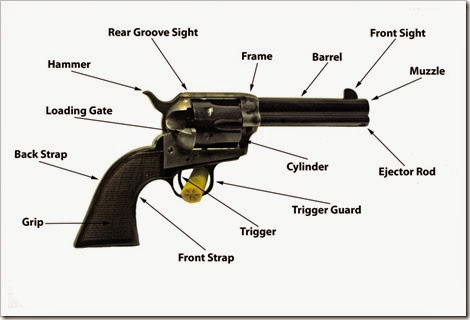
The chassis, the primary component that holds all the parts together is the Frame.
The Barrel is the component that allows the bullet to exit the handgun after it is fired and adds a spin to the bullet to increase its accuracy.
The Muzzle is the region immediately at the end of the Barrel where the bullet exits.
The Front Sight, used in conjunction with the Rear Sight Groove is used to acquire an accurate sight picture prior to engaging a threat.
The Hammer is manually thumbed back to prepare it to strike the primer in the .45 Long Colt cartridge.
The Cylinder contains the cartridges to be fired and rotates a new cartridge into position each time the Hammer is thumbed back.
The Grip is the portion of the revolver that is actually “gripped” by the shooter. The Back Strap fits into the shooter’s palm and the Front Strap provides a purchase for the shooter’s fingers.
The Trigger is the component that is pressed to the rear releasing the Hammer and firing the cartridge.
The Trigger Guard provides protection against an accidental discharge from rubbing the Trigger against clothing or a holster.
The revolver is loaded by opening the Loading Gate, pulling the hammer back a single “click” to free the cylinder and inserting a fresh cartridge, rotating the Cylinder and repeating this step until the Cylinder is fully loaded.
Unloading can be done by holding the Barrel vertical, opening the Loading Gate, pulling the hammer back a single “click” and slowly rotating the Cylinder allowing each expended round’s case to drop out. In the event the case does not drop out, an Ejector Rod is provided to assist in this process.
The name “Single Action” comes from the fact that the trigger performs a “single” function, to release a cocked Hammer to fire the cartridge. Hence, this is a “Single Action” revolver.
This particular weapon is a lot of fun to shoot. I plan to dedicate some time this summer to work on a cowboy quick draw (using wax bullets). I’ll post some photos of my progress.
Saturday, February 4, 2012
The “Boogie Bag” . . . . . for when it’s time to leave!
(My apologies in advance, an impossibly long post – but there simply were no options to make it shorter.)
An earlier post dealt with the initial moments – essentially the first 3 hours – of a survival event. When something unexpected happens, these first few hours will determine whether you have a future or not – they are life critical.
The typical “72-hour” bags are meant to get you through the next 3 days. However, as I have explained, as long as you are not going to die of exposure, it takes little to survive 72 hours other that a personal commitment that you will live to see another day. These systems are mostly meant to “get you home” – where safety and security can be found.
So let’s take it to the next level – the “Boggie” level. You are cut off from home, you are flushed out of your home by either a natural disaster or the “rule of law” has evaporated and your home is no longer safe. Perhaps you are on an extended trip and you can not physically reach home, you need to pick up from where you currently are and survive. The duration for this type of event could be from a week to months. What do you take, how do you prepare, where do you start.
Well, you start here and now – you have all the time you need. The easiest way to approach this is to view it as an extended wilderness trip. If I head out for a week or two, there are certain “basics” that I need in my system to make sure I survive comfortably. While I have no problem with the rigors of the wilderness, and I have taken short weekend trips with minimalist equipment just to flush out the kinks in some of my thinking, it is never my intent to be uncomfortable during one of these excursions. I intend on being warm, dry and comfortable whether it’s 20 below, 100 above, snow or rain. The only thing that determines the length of time on a trip is the “trip plan” and the amount of food I have brought or can scavenge. The gear I take to make this possible can easily be used for a “72-hour” bag as well, just with less food. Then, should the situation deteriorate, your window can be extended by simply adding food. So, let’s look at what goes into my “Boogie Bag”.
Over the past 30 years or so I have refined my “GearList”. I am currently on version 4 due to this particular post. I have added hyper-links to Amazon to specific
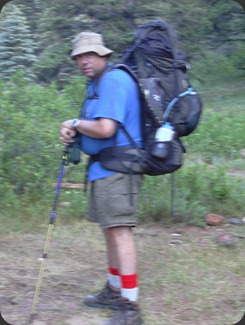 products that are either exactly what I have or are so similar that there is no practical difference. I use everything on the list on one trip or another. You will note two separate lists – a Standard Backpack and a Lightweight List. They are exactly that – the Standard is my typical load-out. The Lightweight is me playing with the edges of comfort vs. weight.
products that are either exactly what I have or are so similar that there is no practical difference. I use everything on the list on one trip or another. You will note two separate lists – a Standard Backpack and a Lightweight List. They are exactly that – the Standard is my typical load-out. The Lightweight is me playing with the edges of comfort vs. weight. First, some rules of thumb. Your “base weight” – the weight of your pack (including the pack itself) should be between 25-30 pounds. Remember, you are going to carry everything you need with you so high quality, lightweight equipment is essential.
Water weights 2 pounds per Nalgene, you’ll want to carry 3. Food typically costs you 2 pounds per day per day. Finally, clothing. These items will drive up your weight quickly.
Another “typical” guideline is that your final pack weight should be about 25% of your body weight. This will never happen. Shoot for something under 60 pounds, that is much more realistic and will help you to realize just what your true situation is should you ever truly need to grab your “boogie bag” and hit the road.
Let me talk about the different sections in my GearList first, and then I’ll delve into the specifics of each section.
Camp
This can generally be considered what you need to make a “home” – a tent, sleeping bag, mattress, a tarp, saw, walking sticks, etc.
Personal Hygiene
Keeping clean in the wilderness is much more important than during your typical day. Small injuries can become seriously infected. A simple cut can take you out of the ball game completely. Keep clean, take it serious.
Repair Kit
These are simple items that can be used to repair gear.
Camp Bag
These are items that are needed around your camp – ropes, fire starting tools, stakes, etc.
Kitchen
What ever you need to cook, flavor and eat a meal.
Navigation / Signaling / Communications
Equipment to get you where you are going, tell you where you are, communicate with the rest of your party or, in the event of the world actually coming to an end, the ability to communicate with others outside of your immediate area.
Knife / Tools
They are simply a required basic of any trip. These two particular items are part of my EDC system.
Clothing
Clothing should be build for wilderness travel; quick dry pants, wicking shirts – undershirts – and underwear. I would encourage you to stay away from cotton.
Dry Clothing
A dry clothing bag is always kept in reserve; never touch or used unless you have encountered an event where all other clothing is unusable.
Trip Clothing
The clothing you actually wear. Two sets – a travel set that is worn to travel then washed and hung to dry overnight. And a camp set that is worn after camp is setup and you are ready to wind down for the day.
Food Kit
I have provided links to various kinds of foods that I typically use for wilderness trips. I have little patience for the energy bar approach that many 72-hour bags use. With a little forethought, you can easily put good tasting food in your bag. Remember to double portions because of the energy you’re burning in your travels. And don’t forget comfort food – candy and snacks.
Normal Survival Kit
This is the kit my students build during their wilderness survival course. I use a square aluminum tin to store it that can double as a cooking pot. The kit should be self explanatory, I don’t plan on spending time on it in this post.
Pocket Survival Kit
This is a pocket kit my students also build and fit in an Altoids can. Again, it should be self explanatory and I’m not going to spend much time on it either.
So let’s delve into each section in more detail.
Camp
This area’s main purpose is to provide you some place dry, comfortable and it give you the ability to get out of the weather if need be. My components consist of a tent, tarp and sleep system with a sleeping bag and Thermarest mattress.
I’ve given you 3 tents I use. One is a Kelty single-person tent. This thing is s
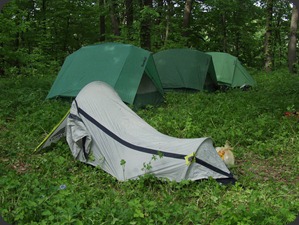 imply b omb proof. I have stayed warm and dry through the worst the rains of the Rockies could throw at me and woke up smiling. It’s advantage is size and weight. But, it is a single-person tent.
imply b omb proof. I have stayed warm and dry through the worst the rains of the Rockies could throw at me and woke up smiling. It’s advantage is size and weight. But, it is a single-person tent. The MSR “Missing Link” (now with some new spiffy name I have already forgotten”) is a “single-wall” tent, meaning that there is no rain fly, it has only a single waterproof wall. The advantage here is less weight and more space (this is a 2-person tent albeit a bit tight) but it also keeps water in so the
 moisture you exhale throughout the night accumulates on the inside of the tent. Keep the vents open as much as you can and set it up early so it can try again before you climb in for the night.
moisture you exhale throughout the night accumulates on the inside of the tent. Keep the vents open as much as you can and set it up early so it can try again before you climb in for the night. Finally, the Eureka 4-person “A” frame, this is one of the best tents ever built. If it’s at all possible, this is the tent I will take. The down side – weight, as simple as that. Plus side – ROOM. It’s is fairly
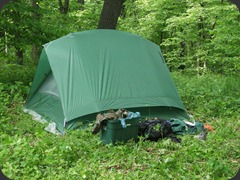 easy to distribute the weight into two bundles, one for you and one for your hiking partner.
easy to distribute the weight into two bundles, one for you and one for your hiking partner. As for sleeping systems, I always start with a summer bag and build from there. By adding a fleece liner/blanket you can add another 10 degrees. And by adding a down comforter can reach 0F easily. Below that takes a bit more special attention. With this system while winter camping, I usually forgo the tent and opt just for a tarp to keep new snow off, or find a nice pine to sleep under.
I believe a tarp is a must, during a long rainy period it’s impossible to just stay in
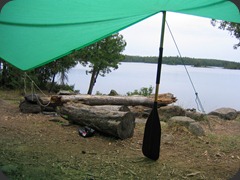 your tent. A tarp gives you flexibility to sit, read, cook – to just enjoy the day, even if it’s rain filled.
your tent. A tarp gives you flexibility to sit, read, cook – to just enjoy the day, even if it’s rain filled. I wouldn’t travel without walking sticks anymore. One, they become the tent polls for my MSR shelter. Or they can be the polls to set up the tarp. And, they can keep you from taking a header while on the trail.
Kitchen
I have provided links to everything from a Fuel Tab stove to a MSR Whisperlite International. Lots of choices – that depend on the
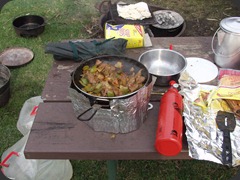 length of the trip and availability of fuel. My preference is the MSR stove. And the International version allows you to burn standard gasoline as well. A Large and Small fuel bottle will easily get you through a week of meals. I always pour from the large to the small bottle and use that on the stove.
length of the trip and availability of fuel. My preference is the MSR stove. And the International version allows you to burn standard gasoline as well. A Large and Small fuel bottle will easily get you through a week of meals. I always pour from the large to the small bottle and use that on the stove. There are tons of kitchen kits – I have linked to those similar to mine. Remember, every ounce
 counts. I also have the coffee pot double as a carrier for the stove just to help protect it. And, use the wind screen for the stove, it radically cuts the amount of fuel needed to cook a meal.
counts. I also have the coffee pot double as a carrier for the stove just to help protect it. And, use the wind screen for the stove, it radically cuts the amount of fuel needed to cook a meal. Navigation / Signaling / Communications
A good compass and a solid knowledge of how to use it is one of the most important basic skills everyone should know. The one linked to is the one I put around my neck when I head out. It never comes off, even at night. If I make a potty stop in the middle of the night and get turned around, I’m not going to be able to go back to my tent and pick it up to find out which way I’m headed – it’s already too late.
I love the Garmin GPS. This is the current version of the one I use. It can hold every map Garmin Mapquest offers – you simply need to buy this and throw it in your bag.
The Motorola radios are similar to the 10 year old ones I currently have. These can be indispensable in keeping a group together. However, their ranges are vastly inflated. You can dependably expect a couple miles, anything more is just gravy.
The Yeasu 857 and the BuddiPole is your “holy crap – it really hit the fan” c
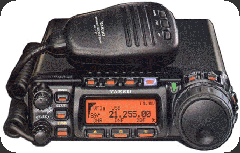 communications system. I have the desktop version of this radio and it is very reliable. And I love the antenna system. It runs off 12 volts, so you can
communications system. I have the desktop version of this radio and it is very reliable. And I love the antenna system. It runs off 12 volts, so you can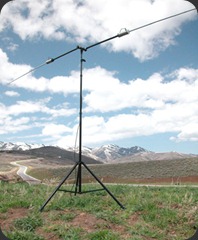 use a car battery to power it. It also has a low-power setting to extend battery life. This system will require you to acquire a new skill set and become a licensed Amateur Radio Operator (Ham). But, I believe it’s worth your time.
use a car battery to power it. It also has a low-power setting to extend battery life. This system will require you to acquire a new skill set and become a licensed Amateur Radio Operator (Ham). But, I believe it’s worth your time. Just a couple cautions about communications in general. Everyone can listen in – be careful what you say. If you are in a survival situation, don’t reveal your location, don’t say how many are in your party, don’t reveal your defensive capabilities or how much food you have or what kind of shelter you have. Limit the length of your conversations to less than 30 seconds if possible – it’s not hard to triangulate your position. Just remember – every bad guy that’s out there is listening.
Knife / Tools
The Kershaw and the Juice are part of my EDC. Buy them; put them in your pocket tomorrow! Nuff said.
Clothing
Going home clothes: If you are out on a practice run or an actual practice trek – throw a complete set of clean clothes in the car, put your stinky, smelly clothes in the trunk and enjoy the drive home.
For travel there are three sets of clothes.
Your “Dry Bag” – these are clothes you have put in a 2-gallon ziplock that you NEVER TOUCH. These are your emergency clothes – you rolled you canoe and everything’s wet – I just came through the rainstorm from hell and everything’s wet – I just fell through the ice and everything’s wet – clothes. Don’t touch’em.
Your travel clothes are those you wear throughout the day. They should be quick dry, wicking and NOT COTTON!!! Lot’s of good options out there. At the end of the day, shuck them, hang them to “air wash” (or if you are near plentiful water – wash them and hang them to dry) and change into your camp clothes. These you will only wear around camp – at night strip them off and sleep in your undies. Then, in the morning, pack these (again in a 2-gallon ziplock just in case) and put your trail clothes back on.
Finally – The Food
Plan a menu, put each day (all three meals) in a 2-gallon ziplock and load up 7 days food in your pack. Each ziplock will weigh around 2 pounds so 7 days is 14 pounds. Another option is to have a separate food pack that attached to your backpack or you can carry on your front. These can be easily hung at night to keep them away from animals. Plan for 2 weeks. You already have a good solid “home” on your back. All you will need to do is resupply food and replace clothing going forward should things remain in the crapper for more than 2 weeks.
You should use your food as well. Either use in on practice treks (otherwise known as vacations) or eat it at home and rotate in new food.
Final thoughts
You have all the time you need today to put a system together – start. You need practice at using it. Just as you go to the range to hone your weapon skills, you need to go to the wilderness to hone your survival skills – plan a trip. Start with an overnight, then a weekend, then a “long weekend’, then a week and finally, take a 2-week trek to really wring things out. Make notes, learn, adjust – you have all the time in the world today.
Remember: Help is NOT COMING. YOU ARE RESPONSIBLE FOR YOUR OWN SURVIVAL. Get Started!!
Weapons
Reader Steph
en pointed out that weapons needed to be part of the package as well. Something about the word “ASSUME” comes to mind, my mistake . . . . .
My load-out would consist of my Glock 17 and all the magazines I have fully topped off (I believe I’m up to a dozen right now). My holster of choice is a strong side Blackhawk Serpa. However, a thigh rig would probably work better with a pack that has a large waist belt. A couple hundred extra rounds would also find their way in the pack keeping in mind they are close to a pound a brick. Added to this would be my LC9 as a Back Up Gun, concealed a bit deeper than the Glock.
I would never leave home without one of my trusty Ruger .22/45s. They are small, accurate and can shoot .22 ammo all day long. I am currently fond of the new CCI Tactical .22 round, they seem to jam less frequently than “standard” .22 ammo. 500+ rounds could easily be carried without much of a weight penalty.
As for a long gun, I currently have a Panther Arms .308. Downside – weight, weight, weight . . . Plus side – a lot of fire power. Sometime this spring I will be adding an AR in .223 – that would probably replace the .308. Of course, depending on how the whole boogie process played out, I would take as many of my weapons as I could.
My gear list as a starting point . . .
|
Notes: Updated with Photos and Weapons 2/5/2012
Subscribe to:
Posts (Atom)
